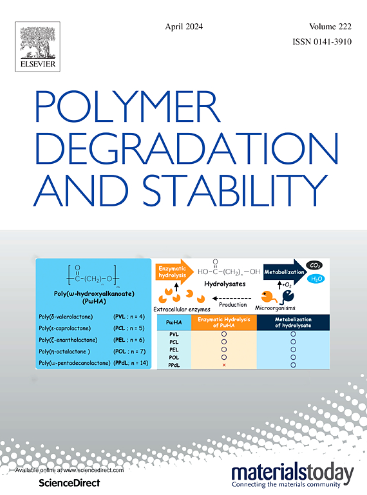热塑性聚氨酯的坚固炭化结构:含炔基环三磷腈结构及其对热降解、燃烧行为和韧性的影响
IF 6.3
2区 化学
Q1 POLYMER SCIENCE
引用次数: 0
摘要
热塑性聚氨酯(TPU)作为一种多用途工程聚合物,由于其固有的可燃性和较差的炭化能力,在降低火灾危险和保持优异力学性能方面面临着挑战。本研究在不依赖含金属杂化物的情况下,开发了单组分化合物HCAP,在800℃下,由于炔基交联反应产生的自增强,使TPU具有明显的71%的炭化能力,这也使TPU具有优异的炭化能力、阻燃性、防滴性和柔韧性。HCAP的掺入分解催化形成炭化层,同时烷基开始交联反应,进一步强化炭化层,极大地抑制了高温下硬段和软段的分解。在800℃时,仅添加5 wt%的HCAP就能使TPU的焦渣从2.9%提高到18.8%,LOI值达到27.5%,UL-94 V-0额定值也达到了防滴。在气相中存在一定的稀释效应,放热和放烟性能明显降低。此外,HCAP的引入使TPU塑化,使断裂伸长率提高了76.4%,拉伸韧性提高了45%。这一改进使TPU在安全防护领域有了更广泛的应用。本文章由计算机程序翻译,如有差异,请以英文原文为准。
Robust charring construction of thermoplastic polyurethane: Cyclotriphosphazene structure bearing alkynyl and its impacts on thermal degradation, burning behavior and toughness
As versatile engineering polymer, thermoplastic polyurethane (TPU) is up against the challenge of reducing fire hazard and maintaining excellent mechanics due to the intrinsic flammability and poor charring capability. Without relying on metal-containing hybrid, this study developed a single-component compound HCAP with pronounced charring capability with 71 % at 800 °C due to the self-reinforcement derived from the crosslinking reaction of alkynyl group, which also enabled TPU to possess excellent charring capability, flame retardancy, anti-dripping, and flexibility. The incorporation of HCAP decomposed to catalyze forming charring layer, meanwhile, alkynyl group started crosslinking reaction to further strengthen the layer, which enormously inhibited the decomposition of hard and soft segments at high temperature. Only adding 5 wt% HCAP increased the char residue of TPU from 2.9 % to 18.8 % at 800 °C, as well as 27.5 % LOI value and UL-94 V-0 rating accompanied by anti-dripping were also achieved. Along with some dilution effect in gas phase, noticeable reduction was observed for heat release and smoke release behavior. Moreover, the introduction of HCAP brought out plasticization for TPU, which resulted in increased elongation at break by 76.4 % and tensile toughness by 45 %. This improvement endowed TPU with expanded application in safety protection field.
求助全文
通过发布文献求助,成功后即可免费获取论文全文。
去求助
来源期刊

Polymer Degradation and Stability
化学-高分子科学
CiteScore
10.10
自引率
10.20%
发文量
325
审稿时长
23 days
期刊介绍:
Polymer Degradation and Stability deals with the degradation reactions and their control which are a major preoccupation of practitioners of the many and diverse aspects of modern polymer technology.
Deteriorative reactions occur during processing, when polymers are subjected to heat, oxygen and mechanical stress, and during the useful life of the materials when oxygen and sunlight are the most important degradative agencies. In more specialised applications, degradation may be induced by high energy radiation, ozone, atmospheric pollutants, mechanical stress, biological action, hydrolysis and many other influences. The mechanisms of these reactions and stabilisation processes must be understood if the technology and application of polymers are to continue to advance. The reporting of investigations of this kind is therefore a major function of this journal.
However there are also new developments in polymer technology in which degradation processes find positive applications. For example, photodegradable plastics are now available, the recycling of polymeric products will become increasingly important, degradation and combustion studies are involved in the definition of the fire hazards which are associated with polymeric materials and the microelectronics industry is vitally dependent upon polymer degradation in the manufacture of its circuitry. Polymer properties may also be improved by processes like curing and grafting, the chemistry of which can be closely related to that which causes physical deterioration in other circumstances.
 求助内容:
求助内容: 应助结果提醒方式:
应助结果提醒方式:


